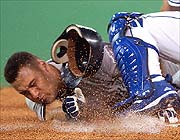On a busy day in the Yankee Universe, we continue our look at the Yankees By the Decade with a stop at the Hot Corner. For the last six seasons, A-Rod has owned that position, and he is clearly the third baseman of the decade. It’s not even close.
[TABLE=48]
To get a sense of just how good A-Rod has been at third base, let’s look at some comparative numbers. For the table above, I used players who had played at least ten games at third base. Thus, Gary Sheffield’s brief 2004 cameo at the Hot Corner and other similarly misguided experiments from the past decade are not covered here. As it stands, A-Rod enjoyed 54.6 percent of the Yanks’ third base at-bats and around 55.8 percent of all plate appearances. My, how he delivered.
In those at-bats, A-Rod was responsible for 72.9 percent of all Yankee third base home runs, 64.4 percent of the walks and 83 percent of the intentional walks. He accounted for 65.4 percent of all third base RBIs, and without his stunning .301/.401/.566 line, Yankee third basemen hit .245/.313/.393. He simply towers above anyone else including old fan favorite Scott Brosius and 2003 hero Aaron Boone.
What is amazing though about this decade of A-Rod is how tumultuous it has been. It began with a near-trade to the Red Sox in late 2003 that fell apart over Boston’s reluctance to pony up the dough. After the proposed Manny-for-Alex swap fell through, the Yankees swooped in and landed A-Rod and his contract for Alfonso Soriano and Joaquin Arias. The Yanks were the only team that could afford A-Rod’s astronomical salary, and they gave up nothing too great in return.
For A-Rod, it was a tough adjustment to New York. He had a down-for-him year in 2004, hitting just 36 home runs with a line of .286/.375/.512. He was great in the ALDS against the Twins and then vanished, along with the rest of the team, in Games 4-7 against the Red Sox in the ALCS. Much as Javier Vazquez was dismissed from New York for his role in the collapse, A-Rod too bore the brunt of the blame, most notably for his slap play in Game 6.
He responded nicely in 2005 and won the first of his two Bronx MVP awards. He hit .321/.421/.610 with 48 home runs and 130 RBIs. Again, though, his post-season numbers were bad. In the ALDS, he went just 2 for 15. The following postseason, he went 1 for 14 in the Division Series, was dropped to eighth in the batting order and drew himself the Choker label.
In 2007, Good A-Rod showed up again, but the fans were wary. On the verge of opting out of his contract, A-Rod hit 54 home runs, drove in 156 and did nothing in October. As the Red Sox were about to win the World Series, he opted out of his contract, and the Yankees vowed never to deal with him again. Three weeks later, he was back in pinstripes for a record deal worth up to $305 million over ten years. The press hated him, and the fans were skeptical.
This past year, the fans finally embraced A-Rod. He notched his 12th straight year with 30 home runs and 100 RBIs by blasting two and driving in seven on the final day of the season, and his hot hitting carried over into the playoffs. Against the Twins, Angels and Phillies, A-Rod hit .365/.500/.808 with six home runs and 18 RBIs. As a decade begun with Scotty Bro and celebrated by Aaron Boone came to a close, Yankee fans had finally come to accept A-Rod as he should be, as the third base as the decade and as the team’s offensive star.
Despite early-season articles, despite sports writer consternation, the Yankees are truly better off with Alexander Emmanuel Rodriguez. Make no mistake about it.
 It was March 31, 2003, Opening Day in Toronto. In the third inning of the match-up between the Yankees and Blue Jays, Jeter was on first with one old and Jason Giambi up. The Blue Jays had deployed the Giambi Shift, and when the Yanks’ slugger grounded out to the pitcher, Jeter saw open space in front of him as he rounded second. Johnny Damon may have made it to third against the Phillies during the World Series, but in Toronto, catcher Ken Huckabee rushed to cover the open base.
It was March 31, 2003, Opening Day in Toronto. In the third inning of the match-up between the Yankees and Blue Jays, Jeter was on first with one old and Jason Giambi up. The Blue Jays had deployed the Giambi Shift, and when the Yanks’ slugger grounded out to the pitcher, Jeter saw open space in front of him as he rounded second. Johnny Damon may have made it to third against the Phillies during the World Series, but in Toronto, catcher Ken Huckabee rushed to cover the open base.